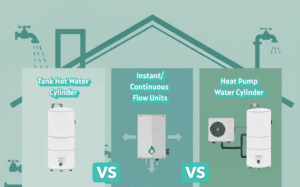Every day, commercial facilities across industries generate millions of litres of contaminated water that requires proper treatment before discharge. From restaurants and hospitals to manufacturing plants and office complexes, businesses face increasing pressure to manage their wastewater responsibly while meeting strict environmental regulations.
The commercial wastewater treatment industry has transformed dramatically over the past two decades. Today’s systems can efficiently process between 1,000 and 500,000 litres daily, serving facilities ranging from small retail outlets to large industrial complexes. Advanced treatment technologies now achieve removal rates exceeding 95% for most contaminants, making compliance achievable for virtually any business type.
This guide examines the critical aspects of commercial wastewater management, helping business owners understand their options, regulatory obligations, and the financial implications of different treatment approaches.
The Business Case for Wastewater Treatment
Economic Impact of Poor Wastewater Management
Inadequate wastewater treatment creates significant financial risks for businesses. Regulatory violations in New Zealand can result in penalties ranging from thousands to millions of dollars, depending on the severity and jurisdiction. Beyond fines, businesses face potential shutdowns, costly remediation projects, and long-term monitoring requirements.
Consider the restaurant industry, where improper grease management can lead to municipal sewer blockages costing tens of thousands in emergency repairs. Similarly, manufacturing facilities that discharge untreated chemicals may face criminal charges and permanent operating restrictions.
Return on Investment for Treatment Systems
Quality wastewater treatment systems typically pay for themselves within 3-7 years through reduced disposal costs, lower municipal fees, and avoided penalties. Many businesses also benefit from water recycling opportunities, reducing overall consumption by 20-40%.
Energy recovery presents another advantage. Anaerobic treatment systems can generate biogas sufficient to power facility operations, while heat recovery from treated water reduces heating costs. Some facilities achieve energy neutrality or even become net energy producers.
Insurance and Liability Considerations
Environmental liability insurance increasingly requires documented wastewater management practices. Businesses with proper treatment systems often qualify for reduced premiums, while those without face coverage limitations or exclusions.
Additionally, proper treatment protects against third-party claims from neighbouring properties or downstream water users.
Understanding Your Wastewater Characteristics
Industrial Wastewater Categories
Food Service Operations generate wastewater high in fats, oils, grease, and organic matter. These facilities require specialised pretreatment to prevent municipal system damage and typically need grease traps, oil separators, and biological treatment components.
Healthcare Facilities produce wastewater containing pharmaceuticals, disinfectants, and potentially infectious materials. Treatment must address both chemical contamination and pathogen removal, often requiring advanced oxidation processes and extended disinfection.
Manufacturing Industries create highly variable wastewater depending on the processes used. Metal finishing operations require heavy metal removal, while textile facilities need colour and chemical treatment. Each industry type demands customised treatment approaches.
Contamination Assessment Methods
Professional wastewater characterisation involves sampling over multiple days to capture operational variations. Key parameters include biochemical oxygen demand (BOD), chemical oxygen demand (COD), total suspended solids (TSS), pH levels, and specific contaminants relevant to your industry.
Seasonal variations significantly impact treatment requirements. Hotels and restaurants experience peak loads during busy periods, while some manufacturing facilities have cyclical production schedules. Understanding these patterns helps optimise system sizing and operation.
Modern Treatment Technologies Explained
Biological Treatment Innovations
Moving Bed Biofilm Reactors (MBBR) represent a significant advancement in biological treatment. These systems use plastic media that provides surface area for beneficial bacteria while remaining in suspension. MBBRs handle shock loads better than traditional systems and require minimal maintenance.
Integrated Fixed-Film Activated Sludge (IFAS) combines suspended growth and attached growth processes in a single reactor. This hybrid approach achieves superior nitrogen removal while maintaining compact footprint requirements essential for urban commercial facilities.
Physical-Chemical Treatment Options
Dissolved Air Flotation (DAF) systems excel at removing suspended solids, oils, and greases through microscopic air bubble attachment. DAF units achieve 90-95% removal efficiency for these contaminants and work particularly well for food processing and automotive service facilities.
Electrocoagulation uses electrical current to destabilise contaminants, making them easier to remove through settling or flotation. This technology effectively treats metal-containing wastewater and emulsified oils while producing minimal chemical sludge.
Advanced Oxidation Processes
Ozone Treatment provides superior disinfection and chemical destruction capabilities. Ozone systems break down complex organic compounds that biological treatment cannot handle, making them ideal for pharmaceutical and chemical manufacturing facilities.
UV/Hydrogen Peroxide Systems combine ultraviolet light with hydrogen peroxide to create highly reactive hydroxyl radicals. These systems destroy persistent organic pollutants and provide reliable disinfection without harmful byproducts.
System Design and Implementation
Site-Specific Design Considerations
Treatment system placement requires careful evaluation of soil conditions, groundwater levels, and flood risk. Systems installed in flood-prone areas need elevated electrical components and waterproof construction. Similarly, facilities in seismic zones require specialised anchoring and flexible connections.
Climate considerations affect system performance significantly. Cold weather reduces biological activity, requiring larger reactor volumes or heating systems. Hot climates may need cooling systems to prevent excessive temperatures that inhibit treatment processes.
Modular vs. Custom Systems
Modular Systems offer faster installation and predictable performance but may not optimise for specific wastewater characteristics. These systems work well for standard applications like office buildings, hotels, and retail facilities with typical wastewater compositions.
Custom-engineered systems provide optimal performance for unique applications but require longer design and construction periods. Manufacturing facilities, specialty chemical operations, and large mixed-use developments often benefit from custom approaches.
Integration with Existing Infrastructure
Retrofitting treatment systems into existing facilities presents unique challenges. Electrical capacity, available space, and structural modifications must be evaluated early in the design process. Phased installation approaches minimise operational disruptions during construction.
Automation integration becomes critical for facilities with limited maintenance staff. Modern systems can integrate with building management systems, providing remote monitoring and automated adjustments based on flow and load variations.
Operational Excellence and Maintenance
Preventive Maintenance Strategies
Successful wastewater treatment requires systematic maintenance approaches. Daily monitoring of key parameters identifies problems before they become critical. Weekly equipment inspections catch mechanical issues early, while monthly comprehensive reviews ensure optimal performance.
Operator training significantly impacts system performance and longevity. Well-trained staff recognise early warning signs, perform routine maintenance correctly, and respond appropriately to upset conditions. Many treatment failures result from inadequate operator knowledge rather than equipment problems.
Performance Monitoring and Optimisation
Real-Time Monitoring Systems provide continuous data on treatment performance, allowing immediate responses to changing conditions. These systems track parameters like dissolved oxygen, pH, turbidity, and flow rates, automatically adjusting operations as needed.
Data Analytics helps identify trends and optimisation opportunities. Historical data analysis reveals patterns that inform operational improvements, maintenance scheduling, and system upgrades. Predictive analytics can forecast maintenance needs and prevent unexpected failures.
Troubleshooting Common Issues
Biological System Upsets often result from toxic shock loads, nutrient imbalances, or temperature extremes. Recovery requires identifying and eliminating the cause while supporting biological populations through appropriate environmental conditions.
Mechanical Equipment Failures typically involve pumps, blowers, and control systems. Preventive maintenance reduces failure rates, while spare parts inventory ensures rapid repairs when problems occur.
Financial Planning and Budgeting
Capital Cost Considerations
Treatment system costs vary dramatically based on capacity, technology, and site conditions. Basic biological systems for small facilities may cost $50,000-$150,000, while advanced treatment systems for large facilities can exceed $1 million.
Financing options include traditional loans, equipment leasing, and performance-based contracts where service providers guarantee treatment performance. Some jurisdictions offer grants or low-interest loans for environmental improvement projects.
Operating Cost Management
Energy Costs typically represent 30-50% of operating expenses. Energy-efficient equipment, variable frequency drives, and optimisation strategies can significantly reduce consumption. Some facilities achieve net energy production through biogas recovery.
Chemical Costs vary based on treatment requirements but generally represent 10-20% of operating expenses. Proper system operation minimises chemical usage while maintaining treatment effectiveness.
Labour Costs depend on system complexity and automation level. Simple systems may require only part-time attention, while complex facilities need dedicated operators. Remote monitoring can reduce labour requirements for multiple facilities.
Life-Cycle Cost Analysis
Evaluating treatment options requires considering total costs over the system’s expected 20-30 year life. Lower initial costs may result in higher operating expenses, while more expensive systems often provide better long-term value through reduced maintenance and energy consumption.
Residual value considerations include system expandability, upgrade potential, and resale value. Systems designed for easy expansion accommodate business growth, while obsolete technologies may require complete replacement.
Making the Right Investment Decision
Selecting appropriate wastewater treatment technology requires balancing multiple factors, including regulatory requirements, operational constraints, and financial considerations. The most expensive system isn’t always the best choice, nor is the cheapest option necessarily the most economical long-term solution.
Successful implementations begin with thorough wastewater characterisation and realistic assessment of treatment objectives. Professional consultation helps navigate complex technical and regulatory requirements while identifying opportunities for operational savings and environmental benefits.
The wastewater treatment investment should align with your business’s operational goals, growth plans, and environmental commitments. With proper planning and implementation, commercial wastewater treatment systems provide reliable, cost-effective solutions that protect both your business interests and environmental resources for decades to come.
Check out our article on How to Choose a Drainlayer in New Zealand too











